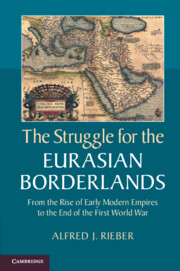 The Struggle for the Eurasian Borderlands
The Struggle for the Eurasian Borderlands Introduction
Published online by Cambridge University Press: 05 June 2014
Summary
This study argues that the great crises of the twentieth century – the two world wars and the Cold War – had common origins in a complex historical process I call the struggle over the Eurasian borderlands. The struggle is conceived as having taken place on two levels: from above, in the course of state-building; from below, in the reaction of the subjugated peoples. The main actors in imperial state-building in Eurasia in the first phase were the Habsburg, Ottoman, Russian, Iranian (Safavid and Qajar), and Qing multicultural empires. In their competition for territory and resources they expanded from their early centers of power along moving, military frontiers, engaging one another in war, diplomacy, and cultural practices for hegemony over the borderlands on their peripheries. From below, the peoples of the borderlands brought under imperial rule strove to maintain their cultures, defend their autonomy, regain or achieve independence either by resisting or accommodating to imperial rule.
The impetus and inspiration for this study came from many years of teaching European, Russian, and comparative history, in the course of which a number of challenging questions kept reoccurring along lines familiar to every student of international relations and global history. How is it possible to explain that, with the exception of the wars of Italian and German unification, all the major wars and some minor ones fought in Europe and Asia from the Congress of Vienna in 1815 to the mid-twentieth century began in the Eurasian borderlands, those territories located on the peripheries of the multinational continental empires, which, after the civil wars and interventions from 1918 to 1920, became successor states? The list of such conflicts is impressive: the Crimean War (1854–1856); the Russo-Turkish War (1877–1878); the Second Afghan War (1879); the Sino-Japanese War (1894–1895); the Russo-Japanese War (1904–1905); two Balkan Wars (1913–1914); the First (1914–1918) and Second (1939–1945) World Wars; the Chinese Civil War (1946–1949); and the Korean War (1950–1953). How further to explain that the continental empires, Habsburg, Ottoman, Romanov, Safavid–Qajar, and Qing, having survived their rivalry over these same territories for centuries, collapsed in revolution and war within little more than a decade between 1911 and 1923? Why was it, finally, that Imperial Russia was involved directly or indirectly in most of these conflicts?
- Type
- Chapter
- Information
- The Struggle for the Eurasian BorderlandsFrom the Rise of Early Modern Empires to the End of the First World War, pp. 1 - 4Publisher: Cambridge University PressPrint publication year: 2014


